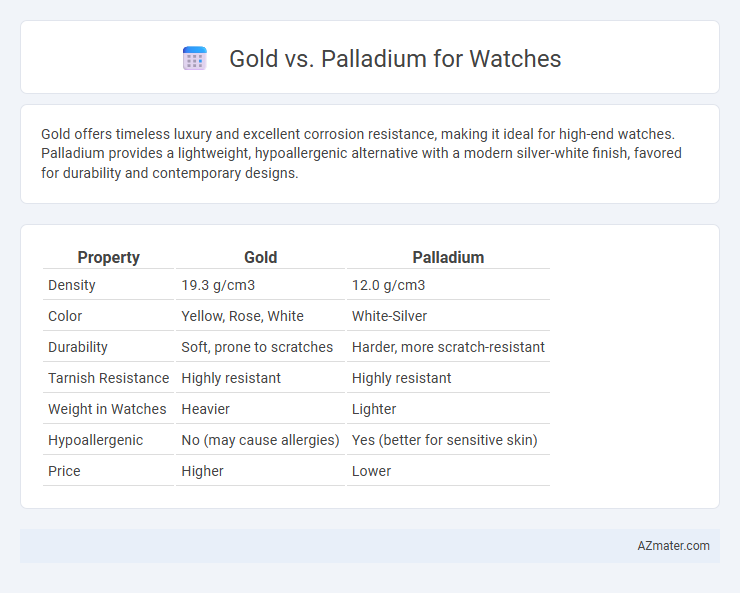Gold offers timeless luxury and excellent corrosion resistance, making it ideal for high-end watches. Palladium provides a lightweight, hypoallergenic alternative with a modern silver-white finish, favored for durability and contemporary designs.
Table of Comparison
| Property | Gold | Palladium |
|---|---|---|
| Density | 19.3 g/cm3 | 12.0 g/cm3 |
| Color | Yellow, Rose, White | White-Silver |
| Durability | Soft, prone to scratches | Harder, more scratch-resistant |
| Tarnish Resistance | Highly resistant | Highly resistant |
| Weight in Watches | Heavier | Lighter |
| Hypoallergenic | No (may cause allergies) | Yes (better for sensitive skin) |
| Price | Higher | Lower |
Introduction: The Allure of Precious Metals in Watches
Gold and palladium stand out as luxurious materials in watchmaking, each offering unique qualities that enhance timepieces. Gold's timeless appeal lies in its rich hue and resistance to tarnish, symbolizing wealth and elegance. Palladium, a rare platinum group metal, provides a modern, hypoallergenic alternative with a sleek silver-white finish, favored for its durability and lightweight nature in high-end watches.
Gold vs Palladium: An Overview
Gold and palladium are popular metals used in watchmaking, each offering unique benefits and characteristics. Gold is prized for its luxurious appeal, impressive durability, and ability to develop a rich patina over time, available in yellow, white, and rose variants. Palladium, a member of the platinum group metals, is valued for its naturally white, tarnish-resistant finish, hypoallergenic properties, and lighter weight, making it an excellent alternative for contemporary watch designs.
Appearance and Aesthetics
Gold offers a classic, warm hue that enhances watch designs with a luxurious and timeless appeal, often preferred for its rich yellow or rose tones. Palladium provides a sleek, modern silver-white finish that resists tarnish and maintains brightness, appealing to those seeking understated elegance with a contemporary edge. The choice between gold and palladium significantly influences the watch's visual impact, balancing traditional opulence against minimalist sophistication.
Durability and Wear Resistance
Gold, particularly in 18k form, offers excellent corrosion resistance and retains its luster over time, but it is relatively soft and prone to scratches. Palladium, part of the platinum group metals, exhibits superior hardness and higher resistance to wear and dents, making it more durable for everyday watch use. Watches crafted from palladium maintain their finish longer under harsh conditions, providing longevity without frequent refinishing compared to gold counterparts.
Weight and Comfort on the Wrist
Gold watches, typically heavier due to gold's high density (19.3 g/cm3), offer a substantial, luxurious feel on the wrist but may cause discomfort during extended wear. Palladium, with a lower density (12.0 g/cm3), provides a lighter alternative that enhances comfort without compromising durability and prestige. Choosing palladium can reduce wrist fatigue, making it ideal for those seeking elegance combined with everyday wearability.
Hypoallergenic Properties
Gold and palladium are both popular metals for watches, but palladium is generally more hypoallergenic, making it ideal for sensitive skin. Pure gold alloys, especially 18K or higher, tend to contain nickel or copper, which can trigger allergic reactions in some individuals. Palladium's natural resistance to tarnish and corrosion ensures long-lasting comfort without skin irritation.
Rarity and Market Value
Palladium is rarer than gold, with annual production significantly lower, which drives its premium market value in the watch industry. Gold's historic status and stable demand maintain its high but more consistent price, while palladium's scarcity and rising industrial use have caused rapid price fluctuations. Luxury watchmakers increasingly favor palladium for exclusive collections, leveraging its limited availability to enhance market appeal and exclusivity.
Maintenance and Tarnish Resistance
Gold watches exhibit excellent tarnish resistance due to their inert properties and dense, corrosion-resistant surface, requiring minimal maintenance beyond occasional cleaning with a soft cloth. Palladium, a member of the platinum group, also resists tarnish effectively but may need periodic polishing to maintain its luster, especially in high-traffic areas exposed to sweat and oils. Choosing between gold and palladium for watch maintenance depends on wear frequency, with gold typically offering longer-lasting shine and lower care demands.
Investment Potential: Which Metal Holds Value?
Gold has long been a stable investment in the watch market due to its enduring global demand and ability to retain value over time, often seen as a hedge against inflation. Palladium, while rarer and more volatile, has experienced significant price surges driven by industrial demand, particularly in automotive catalytic converters, but its long-term investment value remains less predictable compared to gold. Collectors and investors often prefer gold watches for their consistent appreciation, but palladium's scarcity can offer unique opportunities for future value growth in niche luxury markets.
Choosing Between Gold and Palladium for Your Next Watch
Choosing between gold and palladium for your next watch depends on factors such as durability, weight, and price. Gold, available in yellow, white, and rose tones, offers timeless luxury and higher resistance to corrosion, while palladium provides a lightweight, hypoallergenic alternative with a modern silvery-white finish. Consider your budget and style preference, as gold typically costs more but holds classic appeal, whereas palladium suits those seeking contemporary elegance and durability.

Infographic: Gold vs Palladium for Watch
 azmater.com
azmater.com